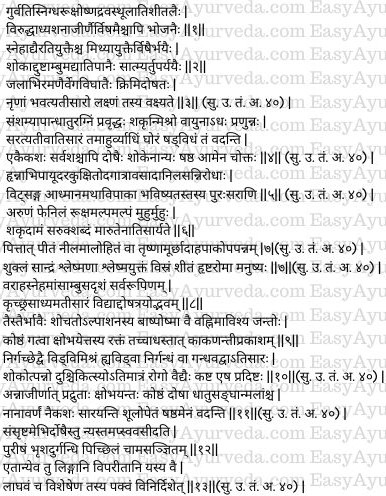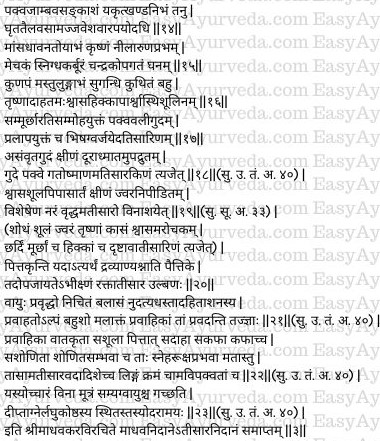Madhava Nidana Chapter 3 Atisara Nidanam
Here in this article we are learning about Madava nidaana 3rd chapter “Atisaara Nidanam”. The causes, pathophysiology and symptoms of diarrhea.
Read – Acharya Madhavakara: His Work ‘Madhava Nidana’, Legacy, Amazing Facts
Table of Contents
Etiological Factors
Etiological Factors of Atisara – Diarrhoea
Over-indulgence in foods which are very heavy (hard to digest), very unctuous (fatty), very dry, very hot, very watery, very hard or very cold; foods which are mutually incompatible (antagonistic), taking foods in large quantities very frequently; foods which are not cooked or processed properly and taken at unusual times; excess or improper usage of therapies like oleation etc., consumption of poisons, fear, grief, drinking of polluted / contaminated water, consumption of excess of alcoholic drinks, changes in accustomed habits and abnormal changes in seasonal features (abnormal seasonal behaviors), over-indulgence in water sports, suppression of natural urges of the body and infestation by worms (intestinal parasites) – are the causative factors responsible for production of the disease atīsāra (diarrhoea). The symptoms of atisara are described herein. (1-3)
Read – Nidana: Meaning, Word Derivation, Definition
Samprapti – pathogenesis
Watery elements of the body undergo increase (following consumption of etiological factors). They then diminish / inactivate the digestive fire, get mixed with faeces, move downwards (out of the body through the rectum) by the action of vāta, in large quantities and very frequently producing the dreadful disease called Atīsāra. It is of six kinds, one from each dosha, one from the combination of the three doșas together, fifth from grief and the sixth from āma (undigested food).(4)
Types:
Vataja Atisara
Pittaja
Kaphaja
Sannipataja Atisara
Shokaja Atisra
Amaja Atisara
Cycle of pathogenesis of Atisara
- Consumption of etiological factors of diarrhoea
- Abnormal increase in watery elements in the body
- Cause diminution / depletion of gastric fire (and weaken the digestion)
- Gets mixed with faeces (increased watery elements get mixed with faeces)
- Gets stimulated and propelled downwards by the action of vata (vata pushes water mixed faeces in the downward direction, towards the colon)
- Excessive and frequent discharge of watery faeces (loose stools)
- This disease is called as atisara – diarrhoea – it manifests in 6 different types
Notes – In Atisara types we can find that apart from those types formed by predominant aggravation of doshas there are 2 special forms. One is caused by ama. Ama is a by-product of sluggish digestion (caused by weak digestive fire – weak capacity of the stomach and intestine to digest the food). If not dealt with properly, this ama can cause different kinds of diseases including atisara. This also reflects that weak digestive power and subsequent formation of ama is one of the main causes for manifestation of atisara. This is called amatisara. The other type i.e. shokatisara is caused by excessive and constant grief. This reflects the psychological component of diarrhea. We also learn that a weak or imbalanced mind or emotional turmoil can cause or trigger the diseases or symptoms of the gastrointestinal system. Nervous diarrhoea is an example of this condition.
Read – Samprapti Meaning, Definition, Types, Examples

Purvarupa – premonitory symptoms
The premonitory symptoms of diarrhoea include – pricking type of pain in the region of the heart, umbilicus, rectum, lower abdomen and flanks; weakness of the body, non-elimination of flatus, constipation, distension of the abdomen and indigestion of food. (5)
Symptoms of Vataja Atisara
Elimination of faeces which is slightly brown in colour, frothy, viscid, less in quantity but expelled very frequently and is accompanied with pain and noise are the symptoms of vātaja atīsāra (diarrhoea due to increase of vāta dosa).(6)
Symptoms of Pittaja Atisara
Faeces which are deep yellow, blue or red in colour; the patient having thirst, fainting, burning sensation and ulcerations (of the alimentary tract) are the symptoms of pittaja atīsāra (diarrhoea due to increase of pitta). (7)
Read – Relationship Of Doshas With Nidana Panchakas
Symptoms of Kaphaja Atisara
Faeces which is white, semi-solid, mixed with mucus and fat, cold and the patient having frequent horripilations (hairs standing on ends) are seen in kaphaja atīsāra (diarrhoea due to increase of kapha).(7)
Symptoms of Tridosaja Atisara
In tridoshaja atisāra (diarrhoea caused due to increase of all the three dosas together) there will be elimination of faeces resembling the fat of wild boar or water in which mutton is washed. The patient will also have the symptoms of all the three doșas. This condition is difficult to cure. (8)
Symptoms of Shokaja Atisara
In persons who are very much afflicted with grief (due to loss of wealth, kith and kin, etc.,), who consume little food or no food at all, the heat of the tears (and also of the fluids of the nose, mouth, throat) increase in quantity. This enters into the alimentary tract and inactivates the digestive fire (digestive activity) and causes vitiation of the rakta dhātu (blood). This vitiated blood resembling the seed of kākaņanti (guñjā – Abrus precatorius) gets expelled out of the body either mixed with faeces or alone (not mixed with faeces), with or without bad smell. This type of atisara – diarrhoea is known as śokātisāra. It is considered by physicians as difficult to cure.(9-10)
Read – IBS: Ayurvedic Treatment, Home Remedies, Lifestyle Tips
Symptoms of Amaja Atisara
In persons in whom the food is not properly digested, the dosas get increased by combining with undigested food. They travel in wrong channels and cause vitiation of koshta (abdominal cavity giving occupancy to many visceral organs, mainly stomach and colon), the dhātus (tissues) and malas (waste products) and cause elimination of faeces of many colours, frequently accompanied with pain in the abdomen. This is the sixth kind of atisara known as āmātisāra (diarrhoea due to indigestion).(11)
Ama and Pakva Atisara
If the faeces associated with the vitiated doshas (and symptoms of aggravated dosas) has foul smell and is very sticky and if it sinks in the water, it (faeces) is said to be ama-mala i.e. faeces associated with ama (uncooked, inadequately processed hence abnormal). On the other hand if the faeces has opposite features of those mentioned above i.e. if it is not associated with foul smell and stickiness and floats on the water, it is said to be pakva mala (well formed, well processed and hence normal). (12-13)
Read – 37 Ayurveda Home Remedies For Diarrhea And Dysentery

Signs of incurability of atisara
Diarrhoea is said to be incurable if the faeces is having the colour of ripened fruit of jambū (jamun fruit), pieces of liver; which is very thin (like water), that which resembles ghee, oil, muscle-fat, marrow, mutton-broth, milk, curds, mutton-wash; which is black, blue, pink, brown or shining black in colour and appearance (like that of collyrium – black and dry); is unctuous (greasy, oily) and having many colors, containing shining particles (resembling the shining particles on the peacock feather), is heavy / scabelous, smells like that of a dead body, brain, putrefied matter or has even a sweet smell and large in quantity.
When the diarrhoea is incurable the patient also has thirst, burning sensation, darkness before the eyes, dyspnoea (difficulty in breathing), hiccough, pain in the flanks and bones, fainting, restlessness, delusion, suppuration in the layers of the anus and rectum (ulcers in the rectum) and delirium. In the presence of these symptoms the physician should reject (not treat) the patient of diarrhoea (because the disease would be incurable). Treatment should be refused to the patients of diarrhoea whose anal sphincters are unable to close, who are emaciated, who have highly distended abdomen, suppuration (ulceration) of the rectum and have very low body temperature.
Diarrhoea is going to kill patients who have increased / difficult respiration (dyspnoea), pain in the abdomen, thirst, emaciation, fever and who are of old age. Likewise, those who have oedema, pain in the abdomen, fever, thirst, cough, dyspnoea, loss of taste (appetite), vomiting, fainting and hiccoughs should also be rejected.(14-19)
Read – Atisara – Charaka Chikitsa Sthana 19th Chapter
Raktatisara
Patients suffering or have suffered from pittātisāra i.e. diarrhoea caused by predominant aggravation of pitta (or even others) who indulge in foods and activities causing increase of pitta, will develop quickly a dreaded disease-raktātisāra (diarrhoea in which heavy bleeding occurs). (20)
Pravahika
In persons who indulge in unsuitable foods, vāta gets increased, and after getting associated with kapha produces the disease called by experts as pravāhikā. In this, the patient will eliminate little quantities of faeces mixed with mucus, frequently, only after straining.
- Vātaja pravāhikā is characterized by elimination of faeces accompanied with pain.
- Pittaja pravāhikā is characterized by elimination of faeces accompanied with burning sensation.
- Kaphaja pravāhikā is characterized by elimination of faeces mixed with kapha (mucus).
- Raktaja pravāhikā is characterized by elimination of faeces with admixture of blood with more moisture or little of it as the case may be.
The other symptoms of this disease and determination of āma (inadequately processed / unripe / unformed) and pakva (adequately processed / ripe / formed) state of faeces are the same as those of diarrhoea. (21-22)
Read – Dysentery: Causes, Symptoms, Ayurvedic Treatment, Medicines
Relieved Symptoms
Symptoms indicating that ‘diarrhoea has been cured’
Atīsāra (diarrhoea) is said to have been cured when the patient is able to eliminate flatus and urine independent of expulsion of faeces (i.e. faeces is not eliminated while passing urine or expelling fart), when his digestion capacity increases (he has developed hunger) and lightness of the abdomen. (23)
Read – Colitis In Ayurveda: Pathogenesis, Causes, Treatment, Diet
Symptoms of Jwaratisara
Jwaratisara is caused by a combination of independent etiological factors of jwara (fever) and atisara (diarrhoea). Similarly the premonitory symptoms, symptoms, aggravating and relieving factors and pathogenesis explained individually in relation to fever and diarrhoea are mixed up (combined) in the clinical picture of jwaratisara. This is the reason that this condition has not been detailed in this context.
Thus ends the chapter on Atīsāra.











